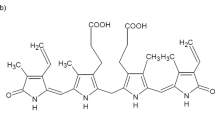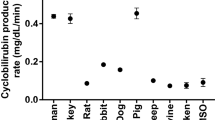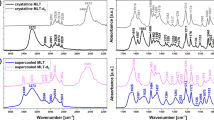Abstract
CRYSTALLINE bilirubin changes with time as noted by Küster1. Newly recrystallized, it dissolves immediately and completely in chloroform. With aged preparations, when dissolved at room temperature, a certain amount of insoluble substance is observed which dissolves within a few seconds when boiled under reflux. This must be due to either an isomerization from bilirubin to dihydrobiliverdin—a displacement of the π electrons from the vinyl to the central methylene bridge2—or a transition between two crystalline phases, the less soluble having the highest thermodynamical stability.
This is a preview of subscription content, access via your institution
Access options
Subscribe to this journal
Receive 51 print issues and online access
$199.00 per year
only $3.90 per issue
Buy this article
- Purchase on Springer Link
- Instant access to full article PDF
Prices may be subject to local taxes which are calculated during checkout
Similar content being viewed by others
References
Küster, W., Hoppe-Seyler's Z., 59, 63 (1909).
Gray, C. H., Bile Pigments in Health and Disease, 16 (Charles C. Thomas, Publ., Springfield, Illinois, 1961).
Fog, J., and Jellum, E., Nature, 198, 88 (1963).
Lemberg, R., and Legge, J. W., Hematin Compounds and Bile Pigments (Interscience Publ., London, 1949).
Fog, J., Diss., Oslo (1960).
Schellong, G., Ikterus Neonatorum, 49 (Thieme Verlag, Stuttgart, 1962).
Author information
Authors and Affiliations
Rights and permissions
About this article
Cite this article
FOG, J., BUGGE-ASPERHEIM, B. Stability of Bilirubin. Nature 203, 756–757 (1964). https://doi.org/10.1038/203756a0
Published:
Issue Date:
DOI: https://doi.org/10.1038/203756a0
This article is cited by
-
Indirect determination of bilirubin by linear sweep polarography
Fresenius' Journal of Analytical Chemistry (1993)
-
Structure of bilirubin
Nature (1976)
Comments
By submitting a comment you agree to abide by our Terms and Community Guidelines. If you find something abusive or that does not comply with our terms or guidelines please flag it as inappropriate.



